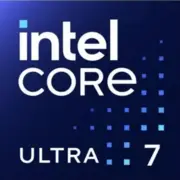Intel Core Ultra 7 265T

The Intel Core Ultra 7 265T processor is a powerhouse for desktop computing. Built on a 3nm technology platform, this processor offers exceptional performance with a total of 20 cores and 20 threads. The base frequency of 2.4 GHz can be boosted up to an impressive 5.3 GHz with Max Turbo Frequency, making it ideal for handling high-demand tasks such as gaming, video editing, and more.
The 24 MB L3 cache ensures smooth and efficient operation, while the 35W TDP (Thermal Design Power) strikes a balance between performance and power consumption, making it suitable for a wide range of desktop systems.
The Arrow Lake-S code name is fitting for this processor, as it truly takes computing to new heights. Whether you're a professional in need of a reliable and powerful processor for demanding tasks, or a gamer looking for seamless performance, the Intel Core Ultra 7 265T delivers on all fronts.
Overall, the Intel Core Ultra 7 265T processor stands out for its impressive specifications, delivering exceptional performance and efficiency for desktop users. It's a top choice for those in need of a high-performance processor for their computing needs.
Basic
Label Name
Intel
Platform
Desktop
Launch Date
December 2024
Model Name
?
The Intel processor number is just one of several factors - along with processor brand, system configurations, and system-level benchmarks - to be considered when choosing the right processor for your computing needs.
Core Ultra 7 265T
Code Name
Arrow Lake-S
Foundry
Intel
Generation
Ultra 7 (Arrow Lake-S)
CPU Specifications
Total Cores
?
Cores is a hardware term that describes the number of independent central processing units in a single computing component (die or chip).
20
Total Threads
?
Where applicable, Intel® Hyper-Threading Technology is only available on Performance-cores.
20
Performance-cores
8
Efficient-cores
12
Performance-core Base Frequency
2.4 GHz
Efficient-core Base Frequency
1.8 GHz
Efficient-core Max Turbo Frequency
?
Maximum E-core turbo frequency derived from Intel® Turbo Boost Technology.
4.5 GHz
Performance-core Max Turbo Frequency
?
Maximum P-core turbo frequency derived from Intel® Turbo Boost Technology.
5.3 GHz
L1 Cache
112 KB per core
L2 Cache
23 MB
L3 Cache
24 MB shared
Unlocked Multiplier
No
CPU Socket
?
The socket is the component that provides the mechanical and electrical connections between the processor and motherboard.
Intel Socket 1851
Bus Frequency
100 MHz
Multiplier
24
Technology
?
Lithography refers to the semiconductor technology used to manufacture an integrated circuit, and is reported in nanometer (nm), indicative of the size of features built on the semiconductor.
3 nm
TDP
35 W
Max. Operating Temperature
?
Junction Temperature is the maximum temperature allowed at the processor die.
100 °C
PCIe Version
?
PCI Express is a high-speed serial computer expansion bus standard used for connecting high-speed components, replacing older standards such as AGP, PCI, and PCI-X. It has gone through multiple revisions and improvements since its initial release. PCIe 1.0 was first introduced in 2002, and in order to meet the growing demand for higher bandwidth, subsequent versions have been released over time.
5
Memory Specifications
Memory Type
?
Intel® processors come in four different types: Single Channel, Dual Channel, Triple Channel, and Flex Mode. Maximum supported memory speed may be lower when populating multiple DIMMs per channel on products that support multiple memory channels.
DDR5-6400
Max Memory Size
?
Max memory size refers to the maximum memory capacity supported by the processor.
256 GB
Memory Channels
?
The number of memory channels refers to the bandwidth operation for real world application.
2
Max Memory Bandwidth
?
Max Memory bandwidth is the maximum rate at which data can be read from or stored into a semiconductor memory by the processor (in GB/s).
102.4 GB/s
ECC Memory Support
Yes
Share in social media
Or Link To Us
<a href="https://cputronic.com/cpu/intel-core-ultra-7-265t" target="_blank">Intel Core Ultra 7 265T</a>